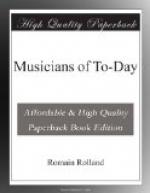[Footnote 146: “Make war against Particularism, that unwholesome fruit of the Protestant heresy!” (Speech to the Schola, taken from the Tribune de Saint-Gervais, November, 1900.)]
[Footnote 147: At least Judaism has the honour of giving its name to a whole period of art, the “Judaic period.” “The modern style is the last phase of the Judaic school....” etc.]
[Footnote 148: In the Cours de Composition musicale M. d’Indy speaks of “the admirable initial T in the Rouleau mortuaire of Saint-Vital (twelfth century), which represents Satan vomiting two Jews ... an expressive and symbolic work of art, if ever there was one.” I should not mention this but for the fact that there are only two illustrations in the whole book.]
[Footnote 149: Cours de Composition musicale, p. 160.]
Haendel’s oratorios are spoken of as “chilling, and, frankly speaking, tedious."[150] Bach himself escapes with this qualification: “If he is great, it is not because of, but in spite of the dogmatic and parching spirit of the Reformation."[151]
I will not try to play the part of judge; for a man is sufficiently judged by his own writings. And, after all, it is rather interesting to meet people who are sincere and not afraid to speak their minds. I will admit that I rather enjoy—a little perversely, perhaps—some of these extreme opinions, where the writer’s personality stands strongly revealed.
[Footnote 150: L’Oratorio moderne (Tribune de Saint-Gervais, March, 1899).]
[Footnote 151: Ibid. As much as to say he was a Catholic without knowing it. And that is what a friend of the Schola, M. Edgar Tinel, declares: “Bach is a truly Christian artist and, without doubt, a Protestant by mistake, since in his immortal Credo he confesses his faith in one holy, catholic, and apostolic Church” (Tribune de Saint-Gervais, August-September, 1902). M. Edgar Tinel was, as you know, one of the principal masters of Belgian oratorio.]
So the old Gothic spirit still lives among us, and informs the mind of one of our best-known artists, and also, without doubt, the minds of hundreds of those who listen to him and admire him. M. Louis Laloy has shown the persistence of certain forms of plain-song in M. Debussy’s Pelleas; and in a dim sense of far-away kinship he finds the cause of the mysterious charm that such music holds for some of us.[152] This learned paradox is possible. Why not? The mixtures of race and the vicissitudes of history have given us so full and complex a soul that we may very well find its beginnings there, if it pleases us—or the beginnings of quite other things. Of beginnings there is no end; the choice is quite embarrassing, and I imagine one’s inclination has as much to do with the matter as one’s temperament.
[Footnote 152: Revue musicale, November, 1902.]




